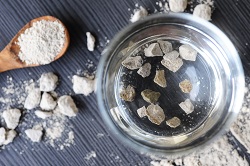EU Scientists use silver to make lights shine more brightly
The toxic and expensive phosphors used widely in fluorescent lighting could be eliminated thanks to a new study conducted by a materials scientist at Queen Mary University of London (QMUL), who is a member of the SACS project consortium. Writing in the journal Nature Materials(opens in new window), the project modified a zeolite mineral to incorporate tiny clusters of silver atoms. At this very small scale (less than 10 atoms), the silver clusters have been shown to be able to emit light. Lead author of the study Dr Oliver Fenwick from QMUL's School of Engineering and Materials Science, said: ‘We've shown that silver atoms can be assembled in the porous framework of minerals known as zeolites with a level of control not reported previously. This has allowed us to tailor very precisely the properties of the silver clusters to meet our needs - in this case an efficient phosphor.’ Not only does these findings allow for the development of more energy efficient lighting, but could also lead to novel solutions in other sectors, such as in healthcare and biological science. ‘The high efficiency of the materials, along with cheap, scalable synthesis makes them very attractive as next generation emitters for fluorescent lamps, LEDs and for biological imaging, for example for highlighting tumours or cell division,’ he outlined. Zeolites are porous minerals that can be found naturally or produced synthetically on an industrial scale. They are rigid and have a well-defined framework made of molecular-scale channels and cavities. There are about 40 naturally occurring zeolites but scientists have also developed dozens of artificial and synthetic zeolites (around 150 in total) that are found in many everyday domestic settings, from laundry detergent, water softeners and filters, and odour control and pet litter. The research manipulated the characteristics of the zeolite pores to fine-tune the properties of the clusters of silver. By tailoring of the zeolite host, they demonstrated luminescence efficiencies close to 100 %, a highly promising result. Additionally, other metals alongside silver have been assessed towards their potential use. The formation of luminescent manganese, lead and gold clusters have also been successfully observed by the project team. The project team is currently working with its industrial partner, Philips Lighting, to integrate silver-containing zeolites into a lamp prototype that could be the basis of an entirely new generation of lighting fixtures. The new phosphors resulting from the SACS project will provide an answer to the need for artificial light sources that have a similar light appearance as natural light. These also have the potential to surpass the performance of the phosphors based on rare earth minerals, which are becoming less readily available due to geopolitical issues and EU restrictions. As the phosphors being developed by SACS are non-toxic, stable, solid, inorganic based materials, they can be easily recycled and reused, and will lead to a more independent and secured phosphor supply throughout Europe. For more information please see: project website(opens in new window)
Countries
Belgium



